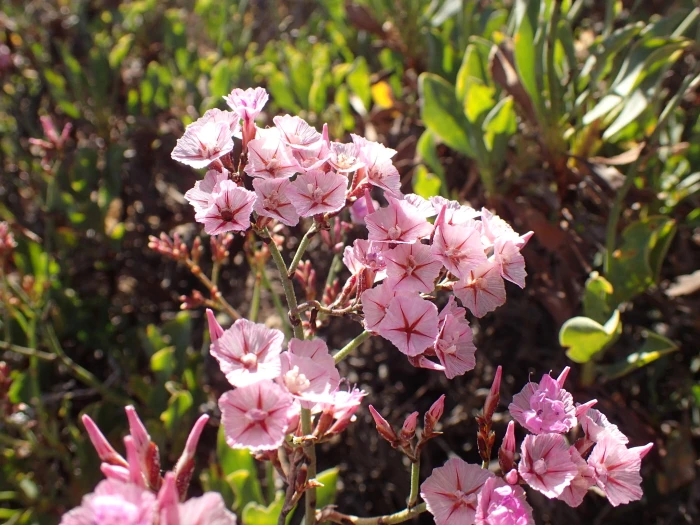Sea Lavender
(Limonium peregrinum)
Sea Lavender (Limonium peregrinum)
/
/

Mahomed Desai
CC BY 4.0
Image By:
Mahomed Desai
Recorded By:
Copyright:
CC BY 4.0
Copyright Notice:
Photo by: Mahomed Desai | License Type: CC BY 4.0 | License URL: http://creativecommons.org/licenses/by/4.0/ | Rights Holder: Mahomed Desai | Publisher: iNaturalist | Date Created: 2021-01-05T16:47:08-08:00 |












Estimated Native Range
Climate Requirements for Cherry Hill, Virginia
| This Plant | Your Site | Plant Suitability for Your Location | ||
|---|---|---|---|---|
| • Precipitation | 5" - 21" | 40" | Aquatic | Aquatic |
| • High Temp. | 74°F - 89°F | 88°F | Your summer temperatures are normal for this plant. | Excellent |
| • Low Temp. | 42°F - 49°F | 25°F | Your winter temperatures may be too cold for this plant | Too cold |
This plant may not grow well at your location - your precipitation is too high.
Summary
Limonium peregrinum, commonly known as Sea Lavender, is an evergreen perennial herb native to coastal areas and saline environments, such as salt marshes and coastal dunes, in the Western Cape of South Africa. It typically grows to a height of 0.5-1 feet (0.2-0.3 meters) and a width of 0.5 feet (0.2 meters). This plant forms a low, bushy mound of leathery, spoon-shaped leaves, and throughout the summer, it bears clusters of tiny, papery, pink flowers on wiry stems that are highly valued for both fresh and dried flower arrangements.
Sea Lavender is appreciated for its drought tolerance and salt resistance, making it an excellent choice for seaside gardens, rockeries, and xeriscaping. It thrives in full sun and requires very low to low amounts of water once established, preferring well-drained soils. It is also used as a ground cover or for edging in dry, sunny beds and borders. While generally pest-free, it can be susceptible to root rot in poorly drained soils. Gardeners should be cautious as it can become invasive in some regions, spreading by both seeds and root systems.CC BY-SA 4.0
Sea Lavender is appreciated for its drought tolerance and salt resistance, making it an excellent choice for seaside gardens, rockeries, and xeriscaping. It thrives in full sun and requires very low to low amounts of water once established, preferring well-drained soils. It is also used as a ground cover or for edging in dry, sunny beds and borders. While generally pest-free, it can be susceptible to root rot in poorly drained soils. Gardeners should be cautious as it can become invasive in some regions, spreading by both seeds and root systems.CC BY-SA 4.0
Plant Description
- Plant Type: Shrub
- Height: 0.5-1 feet
- Width: 0.25-0.5 feet
- Growth Rate: Moderate
- Flower Color: Pink
- Flowering Season: Summer
- Leaf Retention: Evergreen
Growth Requirements
- Sun: Full Sun
- Water: Very Low, Low
- Drainage: Medium, Fast
Common Uses
Bee Garden, Bird Garden, Butterfly Garden, Hummingbird Garden, Low Maintenance, Showy Flowers
Natural Habitat
Coastal areas and saline environments, such as salt marshes and coastal dunes, in the Western Cape of South Africa
Other Names
Common Names: Marsh Rosemary, Dune Sea Pink
Scientific Names: Limonium peregrinum, Limonium roseum, Afrolimon peregrinum, Statice rosea, Statice dickensonii, Statice peregrina, Statice rytidophylla, Statice dicksoniana, Statice perigrina
GBIF Accepted Name: Limonium peregrinum (P.J.Bergius) R.A.Dyer